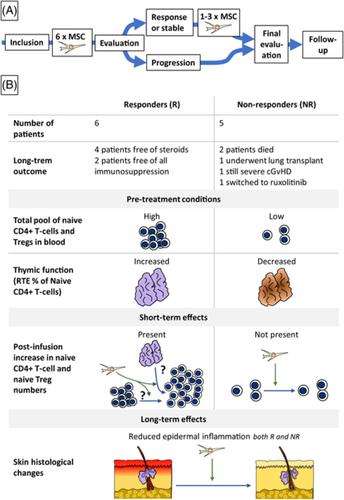当前位置:
X-MOL 学术
›
Stem Cells Transl. Med.
›
论文详情
Our official English website, www.x-mol.net, welcomes your
feedback! (Note: you will need to create a separate account there.)
Treatment of chronic GvHD with mesenchymal stromal cells induces durable responses: A phase II study.
STEM CELLS Translational Medicine ( IF 5.4 ) Pub Date : 2020-06-23 , DOI: 10.1002/sctm.20-0099 Erik Boberg 1, 2 , Lena von Bahr 1 , Gabriel Afram 2, 3 , Carina Lindström 4 , Per Ljungman 3, 4 , Nina Heldring 1 , Peter Petzelbauer 5 , Karin Garming Legert 6 , Nadir Kadri 1 , Katarina Le Blanc 1, 4
STEM CELLS Translational Medicine ( IF 5.4 ) Pub Date : 2020-06-23 , DOI: 10.1002/sctm.20-0099 Erik Boberg 1, 2 , Lena von Bahr 1 , Gabriel Afram 2, 3 , Carina Lindström 4 , Per Ljungman 3, 4 , Nina Heldring 1 , Peter Petzelbauer 5 , Karin Garming Legert 6 , Nadir Kadri 1 , Katarina Le Blanc 1, 4
Affiliation

|
Steroid‐refractory chronic graft‐vs‐host disease (cGvHD) contributes to morbidity after allogeneic hematopoietic stem cell transplantation. Here, we report on 11 patients with severe, refractory cGvHD treated with repeated infusions of allogeneic bone marrow‐derived mesenchymal stromal cells (MSC) over a 6‐ to 12‐month period. Six patients responded to MSC treatment following National Institutes of Health response criteria, accompanied by improvement in GvHD‐related symptoms and quality of life. This response was durable, with systemic immunosuppressive therapy withdrawn from two responders, and a further two free from steroids and tapering calcineurin inhibitors. All responders displayed a distinct immune phenotype characterized by higher levels of naïve T cells and B cells before treatment compared with the nonresponders, and a significantly higher fraction of CD31+ naïve CD4+ T cells. MSC treatment was associated with significant increases in naïve T cells, B cells, and Tregs 7 days after each infusion. Skin biopsies showed resolution of epidermal pathology. CXCL9 and CXCL10 showed differential responses in responder and nonresponder patients. Our data support the use of MSC infusions as treatment for steroid‐refractory cGvHD with durable responses. We propose CXCL9 and CXCL10 as early biomarkers for responsiveness to MSC treatment. Our results highlight the importance of the MSC recipient immune phenotype in promoting treatment response. This trial was registered at www.ClinicalTrials.gov as #NCT01522716.
中文翻译:

用间充质基质细胞治疗慢性 GvHD 可诱导持久反应:一项 II 期研究。
类固醇难治性慢性移植物抗宿主病 (cGvHD) 导致异基因造血干细胞移植后的发病率。在这里,我们报告了 11 名重度、难治性 cGvHD 患者,他们在 6 到 12 个月的时间里反复输注同种异体骨髓来源的间充质基质细胞 (MSC)。根据美国国立卫生研究院的反应标准,6 名患者对 MSC 治疗有反应,伴随着 GvHD 相关症状和生活质量的改善。这种反应是持久的,两名反应者退出了全身免疫抑制治疗,另外两人没有使用类固醇和逐渐减少的钙调神经磷酸酶抑制剂。与无反应者相比,所有反应者都表现出独特的免疫表型,其特征是治疗前的初始 T 细胞和 B 细胞水平更高,和显着更高比例的 CD31+ 幼稚 CD4+ T 细胞。MSC 治疗与每次输注 7 天后幼稚 T 细胞、B 细胞和 Treg 的显着增加有关。皮肤活检显示表皮病理学消退。CXCL9 和 CXCL10 在有反应和无反应患者中表现出不同的反应。我们的数据支持使用 MSC 输注治疗具有持久反应的类固醇难治性 cGvHD。我们建议将 CXCL9 和 CXCL10 作为对 MSC 治疗反应的早期生物标志物。我们的结果强调了 MSC 受体免疫表型在促进治疗反应中的重要性。该试验在 www.ClinicalTrials.gov 上注册为#NCT01522716。皮肤活检显示表皮病理学消退。CXCL9 和 CXCL10 在有反应和无反应患者中表现出不同的反应。我们的数据支持使用 MSC 输注治疗具有持久反应的类固醇难治性 cGvHD。我们建议将 CXCL9 和 CXCL10 作为对 MSC 治疗反应的早期生物标志物。我们的结果强调了 MSC 受体免疫表型在促进治疗反应中的重要性。该试验在 www.ClinicalTrials.gov 上注册为#NCT01522716。皮肤活检显示表皮病理学消退。CXCL9 和 CXCL10 在有反应和无反应患者中表现出不同的反应。我们的数据支持使用 MSC 输注治疗具有持久反应的类固醇难治性 cGvHD。我们建议将 CXCL9 和 CXCL10 作为对 MSC 治疗反应的早期生物标志物。我们的结果强调了 MSC 受体免疫表型在促进治疗反应中的重要性。该试验在 www.ClinicalTrials.gov 上注册为#NCT01522716。我们的结果强调了 MSC 受体免疫表型在促进治疗反应中的重要性。该试验在 www.ClinicalTrials.gov 上注册为#NCT01522716。我们的结果强调了 MSC 受体免疫表型在促进治疗反应中的重要性。该试验在 www.ClinicalTrials.gov 上注册为#NCT01522716。
更新日期:2020-06-23
中文翻译:

用间充质基质细胞治疗慢性 GvHD 可诱导持久反应:一项 II 期研究。
类固醇难治性慢性移植物抗宿主病 (cGvHD) 导致异基因造血干细胞移植后的发病率。在这里,我们报告了 11 名重度、难治性 cGvHD 患者,他们在 6 到 12 个月的时间里反复输注同种异体骨髓来源的间充质基质细胞 (MSC)。根据美国国立卫生研究院的反应标准,6 名患者对 MSC 治疗有反应,伴随着 GvHD 相关症状和生活质量的改善。这种反应是持久的,两名反应者退出了全身免疫抑制治疗,另外两人没有使用类固醇和逐渐减少的钙调神经磷酸酶抑制剂。与无反应者相比,所有反应者都表现出独特的免疫表型,其特征是治疗前的初始 T 细胞和 B 细胞水平更高,和显着更高比例的 CD31+ 幼稚 CD4+ T 细胞。MSC 治疗与每次输注 7 天后幼稚 T 细胞、B 细胞和 Treg 的显着增加有关。皮肤活检显示表皮病理学消退。CXCL9 和 CXCL10 在有反应和无反应患者中表现出不同的反应。我们的数据支持使用 MSC 输注治疗具有持久反应的类固醇难治性 cGvHD。我们建议将 CXCL9 和 CXCL10 作为对 MSC 治疗反应的早期生物标志物。我们的结果强调了 MSC 受体免疫表型在促进治疗反应中的重要性。该试验在 www.ClinicalTrials.gov 上注册为#NCT01522716。皮肤活检显示表皮病理学消退。CXCL9 和 CXCL10 在有反应和无反应患者中表现出不同的反应。我们的数据支持使用 MSC 输注治疗具有持久反应的类固醇难治性 cGvHD。我们建议将 CXCL9 和 CXCL10 作为对 MSC 治疗反应的早期生物标志物。我们的结果强调了 MSC 受体免疫表型在促进治疗反应中的重要性。该试验在 www.ClinicalTrials.gov 上注册为#NCT01522716。皮肤活检显示表皮病理学消退。CXCL9 和 CXCL10 在有反应和无反应患者中表现出不同的反应。我们的数据支持使用 MSC 输注治疗具有持久反应的类固醇难治性 cGvHD。我们建议将 CXCL9 和 CXCL10 作为对 MSC 治疗反应的早期生物标志物。我们的结果强调了 MSC 受体免疫表型在促进治疗反应中的重要性。该试验在 www.ClinicalTrials.gov 上注册为#NCT01522716。我们的结果强调了 MSC 受体免疫表型在促进治疗反应中的重要性。该试验在 www.ClinicalTrials.gov 上注册为#NCT01522716。我们的结果强调了 MSC 受体免疫表型在促进治疗反应中的重要性。该试验在 www.ClinicalTrials.gov 上注册为#NCT01522716。











































 京公网安备 11010802027423号
京公网安备 11010802027423号